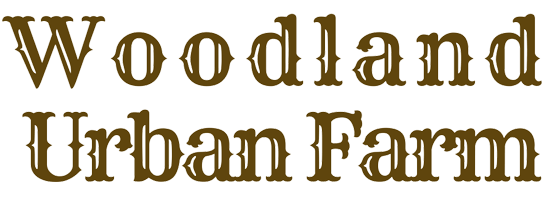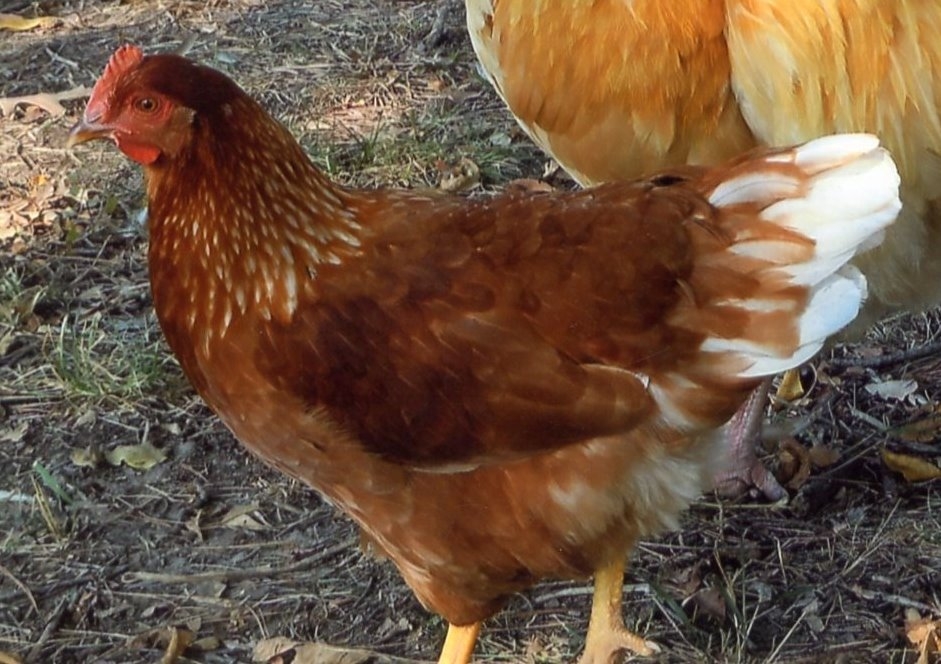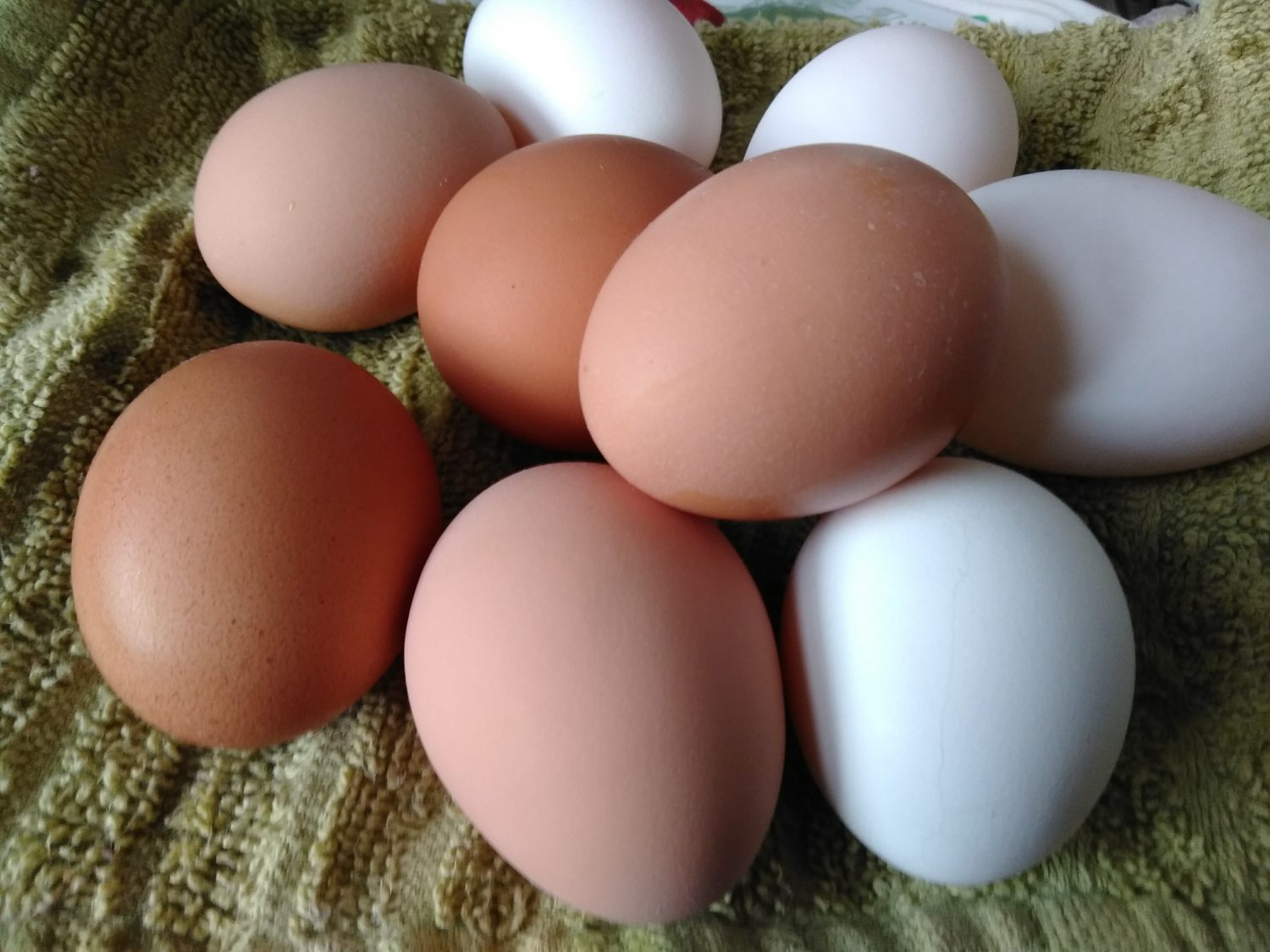Quite simply, the term “free-range” simply means the animals have access to the outdoors. Period. The term has been much abused by factory farms that keep their chickens in a standard poultry house–something like a warehouse with chickens wandering around on the floor–that has a small door open on one end leading to an enclosure that is quite small, relative to the size of the rest of the poultry house. You might think of it as a small balcony outside a large apartment. For that matter, this outdoor enclosure could have a concrete floor. Most of the chickens in such a facility will probably never bother to go outside. They may not even realize it’s an option.
Why do the factory farms bother with the little enclosure if it’s not of any benefit to their flock? Because it entitles them to use the term “free-range” on their packaging, and they know those words conjure images in consumers’ minds of chickens happily wandering the open range. And because people think chickens are better off wandering the open range, they think that’s a more humane way to raise them.
In practice, however, turning chickens loose on open land is simply a way to feed the wildlife–the coyote equivalent of putting out a bird feeder. A popular blogger who goes by the handle “The Chicken Chick” demonstrates this in her recent post, “Chickens, Predators, and the Myth of Supervised Free Range,” wherein she describes how a coyote snatched one of her hens from right behind her back in broad daylight. Even the rooster wasn’t aware until it was too late.
Indeed, the factory farmers who raise caged and “cage-free” birds invoke this negligent form of free-ranging when defending their own practices. Defining “free-range” strictly as letting poultry run around where they’re vulnerable to predation, the confinement house operators claim that their methods are more humane. That’s a disingenuous claim, however, because free-ranging can include much more protective methods.
Some farmers use portable electric netting on pasture. Joel Salatin made this method famous, moving his hens behind his cattle. Some people use portable, bottomless pens called “chicken tractors” or “arcs.” This is what I used when I was first raising chickens as a hobby. I stopped doing it this way, in part because I felt like the pen didn’t offer adequate shelter, despite the fact that it had a roof. I switched to what some have called “day ranging,” which is really what most “free-rangers” do–locking the chickens in a coop at night, and letting them out into a fenced area during the day.
But what qualifies as “outside?” Being inside a barn with a dirt floor is still being inside. If you take down one wall of such a barn and cover the opening with fence wire, anything inside that barn is still inside, isn’t it? But I’ve seen chicken tractors that have tarps or plywood on three sides, with one side covered with fence wire, and the chickens inside them are considered to be pastured. So if you have a three-sided barn and throw fresh sod in there regularly, are the chickens inside pastured? Certainly no, but I doubt there’d be much difference between the diet of chickens raised like that and chickens raised in portable pens on pasture.
But what if the building itself is portable? I’ve seen some farm supply companies selling what looks like basically a carport or a picnic shelter–not unlike my farmers market canopy, only more enclosed. Take a look:
 Would you call that free-range? I wouldn’t. For one thing, it has a floor. That looks more like it should be called “cage free.” Then again, if you look at the cage-free facilities on factory farms, they’re nowhere near this open. They have solid walls all the way around and may not even have any windows.
Would you call that free-range? I wouldn’t. For one thing, it has a floor. That looks more like it should be called “cage free.” Then again, if you look at the cage-free facilities on factory farms, they’re nowhere near this open. They have solid walls all the way around and may not even have any windows.
How about this one?
 I’d definitely call this free ranging, because the fence is well outside the perimeter of the building. The chickens can wander around in a place where there is naturally growing grass under their feet and no roof over their heads. Then again, what if they only had a one-foot strip of ground like that all the way around the house? The house is so open as to not afford any protection against predators or wind. It’s really the worst of both worlds: too confined to meet the expectation of rambling prairies, and yet not protective enough to offer any of the benefits of confinement.
I’d definitely call this free ranging, because the fence is well outside the perimeter of the building. The chickens can wander around in a place where there is naturally growing grass under their feet and no roof over their heads. Then again, what if they only had a one-foot strip of ground like that all the way around the house? The house is so open as to not afford any protection against predators or wind. It’s really the worst of both worlds: too confined to meet the expectation of rambling prairies, and yet not protective enough to offer any of the benefits of confinement.
As I said, I used totally enclosed houses with a door open to a fenced-in area during the day. I found even this was inadequate to prevent predation, though, as predators would just go under or over the fence. I didn’t have electric poultry netting, but I did string a couple electric fence wires along the tops and bottoms of the fences. But this does nothing to keep flying predators from attacking, nor does it keep thieves from simply yanking down the fence and climbing under the top electric wire.
My plan, then, for when I replace my chickens, is to continue with the fully-enclosed house, but with a run that has fence across the top as well. They’ll still be free ranging, and actually, I wouldn’t even have to close their door at night so long as the run is secure enough to keep out raccoons and such. In that respect, then, it’s even more free-range than what I was doing before…but at the same time, it’s more enclosed. Some might even call the run a giant cage.
What do you think? Would you be less likely to buy my chicken and eggs or feel it’s dishonest of me to call it “free-range” if the chickens’ view of the sky was through fence wire six feet overhead, provided they’d still have just as much room to run around under that sky as they’d had before? Is it somehow preferable to let the chickens get killed or stolen?






One thought on “What does “free-range” really mean?”
I’m not sure how old this post/blog is… but I actually was looking for something that was on the same lines as your idea. As open, or large as you want it to be, plenty of space for your hens, yet secure from predators. I see nothing wrong with this at all. In fact, I agree that if a chicken is being raised for food, he aught to reach the table safely, and stress free. This accomplishes both. But instead of the structure being made of a ‘fence’ per se, I would go along with what the chicken chick said about using a metal cloth instead of chicken wire or fencing.
Great post and have a hectic day. Cheers!
John Vincent GI
South Florida